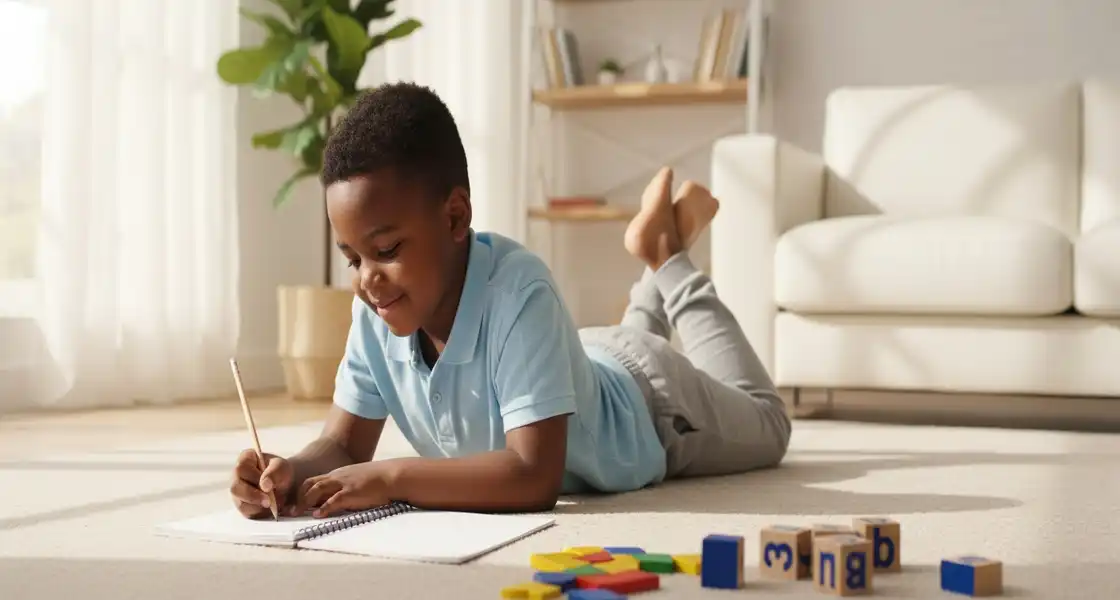Reading fluency starts with knowing the words that show up again and again. High-frequency words are the core vocabulary of early books, everyday speech, and classroom writing. Research reveals that just 100 high-frequency words account for approximately 50% of the text in children's books, which is why helping kids recognize these by sight is one of the fastest ways to boost their reading confidence.
When reading feels fun and progress comes quickly, kids are more likely to stick with it. That’s where Outschool can help, offering creative, interactive sight word classes that give young learners regular practice and real encouragement, all in a playful format that keeps them engaged.
Understanding high-frequency words: What every parent should know
High-frequency words are the building blocks of early reading. These commonly used words show up constantly in books, conversations, and writing. Because they appear so often, recognizing them quickly helps young readers move through text smoothly and confidently. Many of these words are irregular and don’t follow predictable phonics rules, making them hard to sound out. Words like “said,” “was,” and “come” require memorization rather than decoding, which is why they’re introduced early and practiced often.
The goal is for kids to recognize these words instantly, without stopping to figure them out. This frees up mental energy to focus on what the story is about, instead of getting stuck on individual words. When your child starts to spot these tricky words with ease, reading becomes more enjoyable.
Common high-frequency word lists
If you’re teaching your child to read at home, having a word list to guide your lessons can make a big difference. High-frequency word lists help you focus on the most important vocabulary early on, so your child builds confidence and fluency without getting overwhelmed.
The Dolch List: A classic starting point
The Dolch list includes over 200 words selected for early readers. These are words your child will see constantly in beginner books, and many don’t follow regular phonics rules, so memorizing them by sight helps reading flow more smoothly.
Common Dolch words include:
- Kindergarten basics: is, look, we, here, not, come
- 1st Grade favorites: every, from, give, think, when, again
- 2nd–3rd Grade stretch: about, drink, grow, never, together, warm
The Fry List: Expanding vocabulary as they grow
The Fry list is another helpful tool, especially as your child progresses. With 1,000 of the most-used English words arranged by difficulty, it grows with your learner from early reading through more advanced texts.
Fry list examples:
- First 100: at, be, this, had, what, said
- Second 100: made, live, back, much, help, through
- Later levels: finally, questions, reason, understand, brought
Effective ways to teach high-frequency words at home
Teaching high-frequency words doesn't have to feel like drilling flashcards. The most effective ways to teach high-frequency words at home involve making practice interactive, meaningful, and tailored to your child's unique style.
- Create hands-on experiences by having your child write words in sand, rice, or finger paint; trace letters on textured surfaces; or build words with magnetic letters. Research shows that multi-sensory approaches help students master these words better than traditional methods, helping the brain learn in different ways for stronger retention.
- Focus on grade-appropriate Dolch sets. Kindergarten learners might master words like "I," "see," and "go," while first-grade learners can work with "because," "after," and "again", each milestone building reading joy and independence.
- Turn daily activities into word practice by labeling household items, writing grocery lists together, creating treasure hunts with word clues, or having your child spot sight words during nature walks or community outings.
- Make it musical and movement-based through singing word songs, clapping out syllables, acting out word meanings, or playing hopscotch with words written in chalk squares to combine physical activity with recognition practice.
- Adapt your approach for different needs by using larger fonts for visual processing differences, breaking words into smaller chunks for working memory challenges, or incorporating special interests (like dinosaurs or space) into word games for motivated engagement.
- Use engaging sight word activities. Interactive games and structured lessons help learners recognize these words instantly, and you can discover more strategies in our guide on making sight words fun.
- Practice in real reading contexts by choosing books slightly below your child's reading level, where they can successfully recognize many of these words, building confidence while reinforcing recognition in meaningful stories.
What progress can look like
Every child moves at their own pace, especially when it comes to mastering high-frequency words. Some learners pick them up quickly and start recognizing them in books right away. Others may need more repetition and time. The key is consistent practice paired with plenty of encouragement. Progress might not be instant, but it builds steadily, often in ways you don’t expect.
Here are some of the signs you might notice when your child is making progress:
- They start recognizing words in books without sounding them out. You’ll notice smoother reading and fewer pauses as they start identifying common words on sight.
- They use high-frequency words in their own writing. Words like “went,” “said,” or “have” show up in journals, stories, or even simple lists they create on their own.
- They correct themselves while reading. Self-correction is a big step. It shows they’re aware of how words should look and sound, even if they stumble.
- They read with better rhythm and flow. Reading sounds more natural, and they begin grouping words into meaningful phrases instead of reading word by word.
- They show more interest in books. As reading becomes easier, many kids become more excited about picking up books and exploring stories independently.
There’s no rush to master every word on a list. Instead, look for small, consistent signs that your child is connecting with language in a deeper way. With ongoing exposure and gentle encouragement, recognition can build naturally, and each milestone along the way deserves to be celebrated.
Frequently asked questions (FAQs) about high-frequency words
Parents often search for answers about what high-frequency words are and how to teach them effectively at home. These common questions address the practical concerns that come up when supporting your child's reading development.
What's the difference between high-frequency words and sight words?
High frequency words are simply the most commonly used words in children's books and everyday reading, like "the," "and," and "said." Sight words, on the other hand, are any words that readers recognize instantly without having to sound them out. While there's overlap between these two categories, not all high-frequency words need to be memorized as sight words. Many can actually be sounded out using phonics skills.
What if my child struggles to remember high-frequency words?
If your child has trouble with high-frequency word retention, focus on recognition strategies that work for words that don’t follow typical phonics rules. To make words more memorable, try breaking words into smaller parts, using multi-sensory activities like tracing letters in sand, or creating personal connections. Some children need more time and repetition, and that's perfectly normal.
Are there digital tools or resources to help with high-frequency word practice?
Apps with interactive games and phonics-based activities can make high-frequency word practice fun and memorable for young learners. For a more guided approach, Outschool offers live and self-paced classes that blend word recognition with meaningful reading practice, helping kids build fluency in a way that sticks.
How can I integrate high-frequency word practice into real-world experiences?
You can weave high-frequency word practice into everyday moments by turning errands, playtime, or daily routines into learning opportunities. Read signs aloud at the store, label household items with sticky notes, or have your child hunt for target words in books, recipes, or even grocery lists. These real-world touchpoints help reinforce word recognition in ways that feel natural and engaging.
There are also several book series that naturally highlight high-frequency words and make them easier for your child to recognize. Examples include:
- The Adventures of Otto series by David Milgrim
- Elephant and Piggie series by Mo Willems
- Fly Guy series by Tedd Arnold
- I Like to Read series from Holiday House
Nurture your child's confidence in reading
High-frequency words open the door to reading fluency, comprehension, and, most importantly, the joy that comes from independent reading. When children master these foundational words, they gain the self-assurance to explore new stories, dive into their interests, and develop a lifelong love of learning.
Building on these foundations, Outschool's online homeschooling classes offer live, self-paced, and 1:1 options designed to make reading both engaging and successful for every learner. These classes provide the structure and expertise to help them master high-frequency words and develop into enthusiastic, capable readers.


.svg)
.svg)


.webp)




